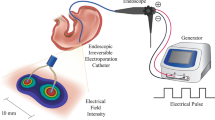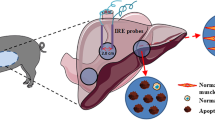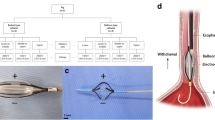Abstract
Purpose
To evaluate the effects of irreversible electroporation (IRE) on the rectum wall after IRE applied adjacent to the rectum.
Material and Methods
CT-guided IRE adjacent to the rectum wall was performed in 11 pigs; a total of 44 lesions were created. In five pigs, ablations were performed without a water-filled endorectal coil (group A); in six pigs, ablation was performed with the coil to avoid displacement of the rectum wall (group B). The pigs were killed after 7–15 days and the rectums were harvested for pathological evaluation.
Results
There was no evidence of perforation on gross postmortem examination. Perirectal muscle lesions were observed in 18 of 20 ablations in group A and in 21 of 24 ablations in group B. Inflammation and fibrosis of the muscularis propria was observed in ten of 18 lesions in group A and in ten of 21 lesions in group B. In group A, findings were limited to the external layer of the muscularis propria except for one lesion; in group B, findings were transmural in all cases. Transmural necrosis with marked suppurative mucosal inflammation was observed in seven of 21 lesions in group B and in no lesion in group A.
Conclusion
IRE-ablation adjacent to the rectum may be uneventful if the rectum wall is mobile and able to contract. IRE-ablation of the rectum may be harmful if the rectum wall is fixed adjacent to the IRE-probe.





Similar content being viewed by others
References
Edd J, Horowitz L, Davalos R et al (2006) In vivo results of a new focal tissue ablation technique: irreversible electroporation. IEEE Trans Biomed Eng 53:1409–1415
Davalos RV, Mir ILM, Rubinsky B (2005) Tissue ablation with irreversible electroporation. Ann Biomed Eng 33:223–231
Rubinsky B (2007) Irreversible electroporation in medicine. Technol Cancer Res Treat 6:255–260
Onik G, Mikus P, Rubinsky B (2007) Irreversible electroporation: implications for prostate ablation. Technol Cancer Res Treat 6:295–300
Onik G (2001) Image-guided prostate cryosurgery: State of the art. Cancer Control 8:522–531
Rubinsky B, Onik G, Mikus P (2007) Irreversible electroporation: a new ablation modality—clinical implications. Technol Cancer Res Treat 6:37–48
Lee EW, Chen C, Prieto VE et al (2010) Advanced hepatic ablation technique for creating complete cell death: irreversible electroporation. Radiology 255:426–433
Deodhar A, Monette S, Single GW Jr, Hamilton WC Jr, Thornton R, Maybody M et al (2011) Renal tissue ablation with irreversible electroporation: preliminary results in a porcine model. Urology 77(3):754–776
Conflict of interest
G. S. is employed by AngioDynamics. The institution of S. B. S. received an unrestricted grant and equipment from AngioDynamics as well as a grant from G. E. Healthcare. S. B. S is also a consultant for GE Healthcare and Johnson & Johnson.
Author information
Authors and Affiliations
Corresponding author
Rights and permissions
About this article
Cite this article
Schoellnast, H., Monette, S., Ezell, P.C. et al. Irreversible Electroporation Adjacent to the Rectum: Evaluation of Pathological Effects in a Pig Model. Cardiovasc Intervent Radiol 36, 213–220 (2013). https://doi.org/10.1007/s00270-012-0393-1
Received:
Accepted:
Published:
Issue Date:
DOI: https://doi.org/10.1007/s00270-012-0393-1




